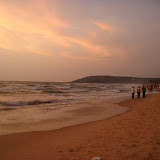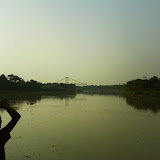The trip was planned suddenly. Multiple considerations needed to be addressed. We were travelling with Sirshendu, my KMDA colleague, and his wife. A journey on the newly introduced Sealdah – New Delhi Duronto was compulsory. For Durba, Sirshendu and Deboleena (Sirshendu’s wife), we had to thow in a Rajdhani ride. A visit to the Taj Mahal was must (I specifically intended it as an anniversary event for Durba and myself). It could have been a Delhi – Jaipur – Agra golden triangle tour. But after taking everything into account, we decided to include Udaipur as well. Finally, the itinerary looked like this:
February 18 – Board the evening Duronto from Sealdah.
February 19 – Arrive in Delhi by noon. Quick rest and lunch at the ITPI guest house. Then visit the Qutb Minar, the Baha’i Temple and Humayun’s Tomb in the afternoon. Board Mewar Express to Udaipur from Hazrat Nizamuddin in the evening.
February 20 – Arrive at Udaipur early in the morning. Check in at the ITPI guest house. Spend the day sight-seeing. Overnight stay at the guest house.
February 21 – Visit to Chittorgarh Fort and back to Udaipur (Nathdwara and Haldighati were thrown as additions on the spot). Start for Jaipur in the evening by the Agra express.
February 22 – Arrive at Jaipur early in the morning. Check in at the ITPI guest house. Spend the day sight-seeing (We did the Museum, the Jantar Mantar, the City Palace and the Aamer fort during the day. The evening was spent at the Chokhi Dhani grounds). Night-stay at the ITPI guest house.
February 23 – Take a car in the morning to visit Pushkar and Ajmer and return to Jaipur in the evening. Night-stay at the ITPI guest house.
February 24 – Visit to the Jal Mahal and the Jaigarh and Nahargarh forts during the day. Some shopping post-lunch. Then board an evening bus to Agra. Reach Agra late at night. Check in at the Shanti Lodge.
February 25 – Visit to Taj Mahal at first light. Visit to Agra fort and the other places of interest in Agra during the day. Then back to the Taj to experience it in its evening glory. Night-stay at the Shanti Lodge.
February 26 – Take a car to Delhi in the morning. Stop-over at Fatehpur Sikri en-route. Night stay at the ITPI guest house.
February 27 – Durba and I ended up visiting the Jama Masjid and lunching at Karim’s. Board the Sealdah Rajdhani from New Delhi station in the evening.
February 28 – Back to Kolkata in the morning.
Udaipur
I cherish: visit to the palace, the ropeway ride to the temple of Charani Mata, boat ride on the lake.
 |
| From Udaipur, February 2010 |
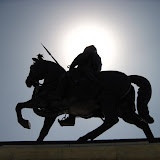 |
| Udaipur, February 2010 |
Chittorgarh
I remember most - the exciting climb up the Victory Tower.
 |
| From Chittorgarh Fort, February 2010 |
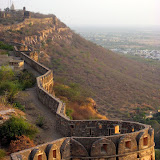 |
| Chittorgarh Fort, February 2010 |
Jaipur
Jaigarh fort tops my list. Aamer is a close second. Lost in history, one is transported several centuries back in time. The afternoon we went to Aamer, Jaipur’s clear blue skies suddenly clouded over and it began to drizzle. The locals said that it was raining after a very long time. We had bought camel-skin shoes from a shop and wore them to Chokhi Dhani in the evening. The drizzle suddenly gave way to an intense downpour that was preceded by a dust storm, thunder and flashes of lightning. The grounds turned mucky and our new camel-skin shoes paid the price! I also remember the acute stomach upset I picked up on our last day at Jaipur, with me sitting anxiously through the entire bus ride to Agra as a result!
 |
| From Jaigarh and Nahargarh Forts, Jaipur, February 2010 |
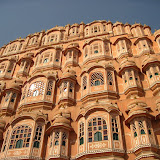 |
| Jaipur, February 2010 |
 |
| Aamer Fort, Jaipur, February 2010 |
 |
| Jaigarh and Nahargarh Forts, Jaipur, February 2010 |
Agra
One big solid-looking Norflox pill did the trick! I was fit for the early morning visit to the Taj after sleeping late at night. Research on the web earlier had suggested that the Shanti Lodge, in old Agra, would be a great place to stay. The Taj was a five-minute walk and the rooftop café was supposed to offer unparalleled views of the edifice. We had booked in advance accordingly. However, when we reached late at night, the staff did not seem too eager to check us in. It dawned on me later that the Shanti Lodge being a preferred address for foreigners, thanks to extensive coverage on Lonely Planet and other international travel literature, the staff is generally apprehensive of the quality of Indian guests. It may sound discriminating but then, it’s understandable that foreign guests would probably not enjoy loudness and other forms of trouble which, unfortunately, some of our countrymen are prone to perpetrating. Shanti Lodge definitely has its advantages in terms of location and view. But it may not be the most comfortable place to stay for all Indians.
The Taj is one of my happiest memories till date. Will remember the walk (the run, rather, rushing as we were to be one of the first visitors of the day) with badly-cracked and painful heels through the winding lane from the Lodge to the Taj. Time seems to have stopped in the alleyways of the old settlement around the Taj, said to be first inhabited by the workers who built the monument. Seeing the Taj through the mist in the first light of the day (my first glimpse ever) made me feel I had fulfilled a major objective of not only this tour but of my entire life till date as well. I returned with a deep sense of peace and calm.
When we visited the Taj in the evening again, a small incident happened –there was some insult from the security forces at the entry who suspected us of being Bangladeshis! Well, probably there have been cases of guests from our neighbouring countries entering with tickets meant for Indians, which are cheaper than the ones meant for foreigners. Probably there was a genuine security concern. Whatever it was, it left a bad taste in the mouth. Still, at the end of the day, when you have experienced the Taj withdrawing into its centuries-old shell of graceful silence in the fading daylight, and seen the full-moon shining behind it, you learn to take lightly the trivia of life…
 |
| From Taj Mahal, February 2010 |
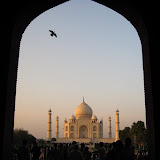 |
| Taj Mahal, February 2010 |
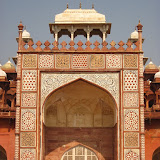 |
| Agra, February 2010 |
 |
| Agra Fort, February 2010 |
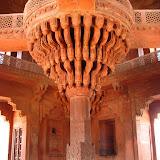 |
| Fathepur Sikri, February 2010 |
Delhi
We were about to leave Humayun’s Tomb in the evening. Our train to Udaipur would start from Nizamudding in half an hour. The sun had set and in the half-light of dusk, the place looked eerie. I suddenly found myself all alone in one of the cells of the Tomb. On one side was a jali through which the last light of the day filtered in. It was almost as if there was a presence other than mine in that confined space. Spooky feeling! It took me some time to get over it and get out of the chamber.
The other memory of Delhi from the tour is that of the Jama Masjid on the day of our return. While we were going round the courtyard of the Masjid, Durba and I suddenly came across a signboard announcing the sale of tickets for a passage up one of its soaring minarets. The forts of Rajasthan had worn down our knees and we were apprehensive of another long and steep climb. But in the end we decided to give it a try. We wound our way slowly to the top where a stupendous sight awaited us – all of Chandi Chowk lay sprawled out below and we could see the Red Fort in the distance, a shining streak behind it announcing the presence of the Yamuna. People and traffic, a multitude of the miniature, combined to resemble a slow moving river. One of the most exhilarating views on any tour so far…
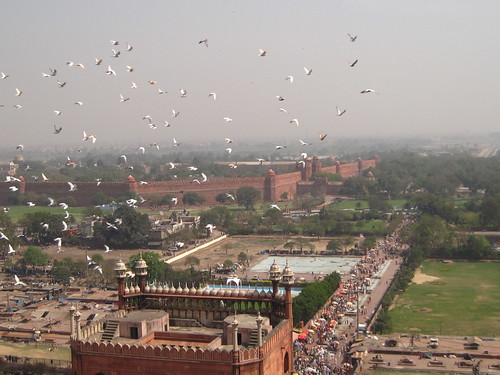
Tour Map
View Delhi, Agra and Eastern Rajasthan tour in a larger map









